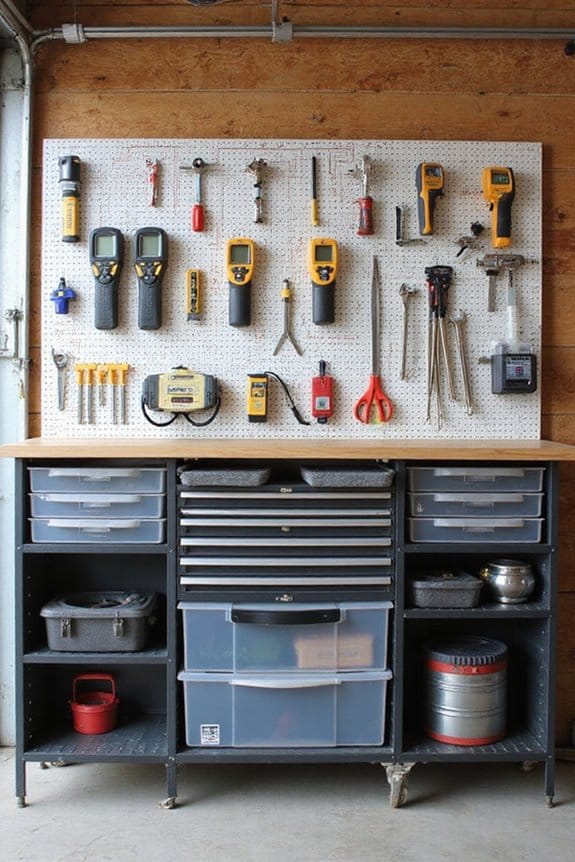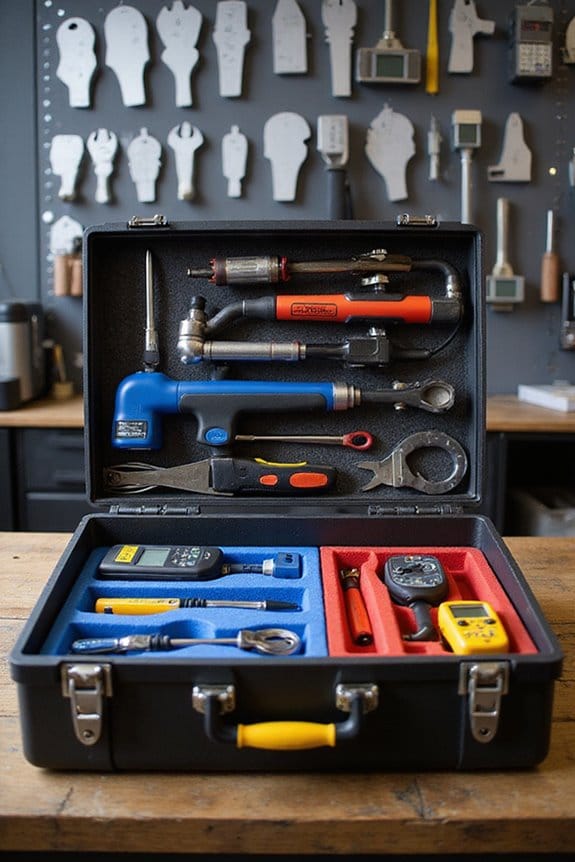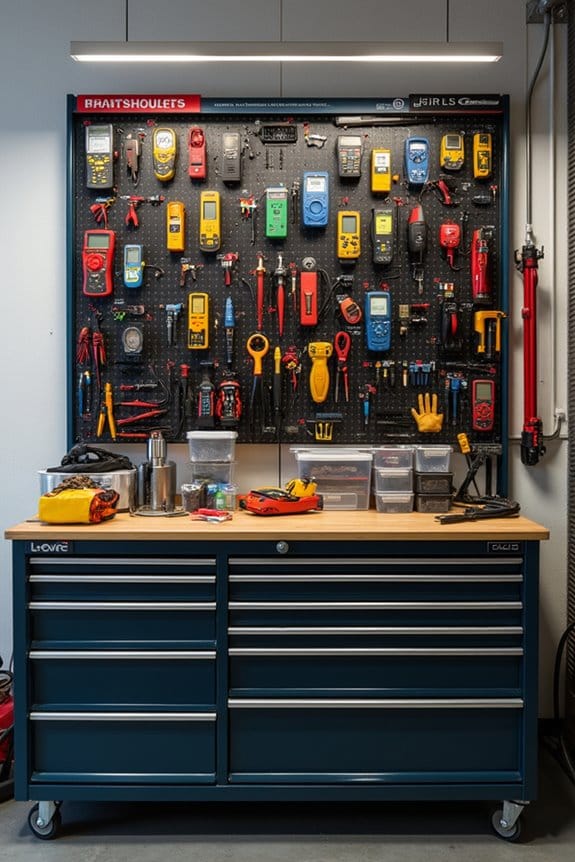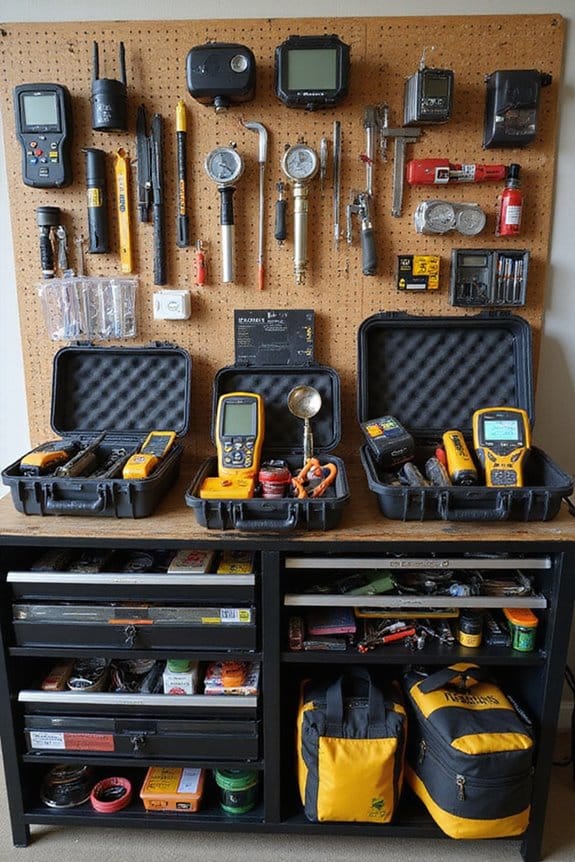Proper tool storage is all about keeping your workspace safe and organized. Here’s how I do it: 1) Use toolboxes or chests for easy access and organization. 2) Try color-coded systems to quickly find tools and prevent mix-ups. 3) Keep tools off the floor to avoid dirt and damage. 4) Add labels for clarity. Each method not only maximizes space but also extends tool life. Stick around, and I’ll share some smart tips to optimize your tool storage further!
Key Takeaways
- Utilize toolboxes for portable, compartmentalized storage, ideal for smaller tool collections and on-the-go tasks.
- Implement vertical storage solutions like pegboards and magnetic strips to keep tools visible and accessible while saving space.
- Adopt color-coded systems for quick identification of tools, reducing misuse and enhancing organization efficiency.
- Designate zones for frequently used tools to improve accessibility and streamline workflow in your workspace.
- Regularly centralize maintenance data and automate alerts to ensure tools are well-maintained and in optimal condition.
Importance of Proper Tool Storage

When it comes to tool storage, you might not realize just how essential it is to keep everything organized and safe. Here’s why proper storage matters for tool safety and worker protection:
- Prevents Injuries: A quarter of workplace injuries stem from falling objects. Storing tools securely minimizes this risk.
- Reduces Clutter: Embracing a “clean as you go” culture means fewer hazards and a safer workspace.
- Extends Tool Life: Proper storage keeps tools dry and protected, preventing rust and damage.
- Streamlines Workflow: With designated spaces, you won’t waste time searching for tools during projects. Additionally, using modular storage systems enhances organization and can adapt to your evolving tool collection.
Effective Storage Method Options

Effective Storage Method Options
Having the right storage method can make a world of difference in how you manage your tools. Here are some effective storage method options to contemplate:
- Toolboxes: Portable and compartmentalized, they’re perfect for smaller collections or essential tools. Just be cautious—their weight can add up!
- Tool Chests: Ideal for extensive collections, these large units offer fantastic organization but need a dedicated space.
- Tool Bags: Lightweight and flexible, they’re great for on-the-go use. Just remember, they might not protect your tools as well as hard cases.
- Vertical Storage: Magnetic strips and repurposed organizers keep tools visible and save space—what’s not to love? Additionally, using ergonomic designs for tool organization can enhance user comfort and efficiency during tasks.
Each of these toolbox types serves a unique purpose, so pick the one that fits your needs!
Hygienic and Color-Coded Storage Practices

To keep your tools in tip-top shape, it’s important to adopt hygienic and color-coded storage practices. Here are my top recommendations:
- Clean Storage Areas: Always use sanitized spaces for your tools. This prevents contamination and guarantees compliance with hygienic guidelines.
- Keep Tools Elevated: Use wall brackets or shadow boards to avoid contact with floors. Trust me, it makes cleaning a breeze.
- Color-Coded Systems: Assign distinct colors for different tools and areas. This helps with quick identification and reduces misuse.
- Separate Clean and Dirty: Physically separate tools to avoid cross-contamination. It’s a simple step that can save you from headaches later!
Space and Safety Optimization Techniques

Keeping your tools organized and safe doesn’t just end with hygienic practices; it also means optimizing the space they occupy. Here are some techniques to evaluate:
- Vertical Storage: Use pegboards, magnetic strips, or wall-mounted systems to keep tools visible and accessible, freeing up valuable floor space.
- Smart Storage Solutions: Invest in toolboxes with compartments or multi-drawer chests to keep everything organized and easy to find.
- Zone Designation: Place frequently used tools in easily accessible spots while storing less-used items higher up or further back.
- Safety First: Follow safety regulations by securing heavy tools and keeping walkways clear to avoid accidents.
- Consider incorporating multi-functional tools into your storage solution, allowing you to save space while maximizing efficiency in your projects.
Integrating Tool Maintenance With Storage

When it comes to tool storage, integrating maintenance might not be the first thing on your mind, but it’s essential for keeping everything running smoothly. Here’s how to do it:
- Centralize Data: Combine all your maintenance and tool tracking info in one platform. This prevents confusion and makes it easier to monitor tool conditions.
- Real-Time Insights: Keeping tabs on tool status helps you perform proactive maintenance. Trust me, it saves you from unexpected breakdowns.
- Link Inventory: Connect your maintenance activities with inventory management. You’ll always know what spare parts you have on hand.
- Automate Alerts: Set up reminders for tool servicing and storage checks. This keeps your tools in peak condition. Additionally, consider tracking calibration schedules to ensure accuracy and reliability of your testing equipment.
With these steps, you’ll enhance your tool storage and maintenance efficiency. Happy organizing!
Organizational and Efficiency Benefits
Organizing your tools isn’t just about making things look neat; it’s a game-changer for efficiency in the workplace. Here’s why:
- Time Savings: Proper tool storage cuts down the time you spend searching for items, letting you focus on getting things done.
- Workflow Enhancement: By categorizing tools by function, you streamline your tasks and reduce interruptions. This means more productivity and less frustration!
- Space Utilization: Efficient storage reduces clutter, making your workspace feel bigger and more functional.
- Safety: A well-organized area minimizes hazards, keeping you safe while you work. Additionally, tool organization tips can further enhance accessibility and efficiency in your workspace.
Frequently Asked Questions
How Do I Choose the Right Storage Solution for My Tools?
When I choose the right storage solution for my tools, I focus on tool organization and space optimization. I evaluate my needs, space, and access frequency to find the best fit for my workspace.
What Are the Costs Associated With Different Tool Storage Options?
Did you know basic plastic toolboxes can cost as little as $20? When considering your storage investment, a cost comparison reveals that higher-end options, though pricier initially, often save money in the long run.
How Can I Customize Storage for Specific Tool Types?
When customizing storage for specific tool types, I like using storage bins for easy organization. By grouping tools by function and labeling each bin, I guarantee quick access and maintain a clutter-free workspace.
What Are the Best Practices for Labeling Tools in Storage?
Did you know that 70% of tool misplacements stem from poor labeling techniques? I’ve found that effective labeling not only boosts storage organization but also saves time, making retrieval a breeze for everyone involved.
How Can I Encourage Team Compliance With Storage Systems?
To encourage team compliance with storage systems, I focus on team motivation and compliance strategies. Regular training sessions and creating a culture of accountability really help everyone understand the importance of proper tool organization and safety.



